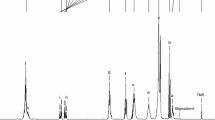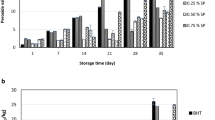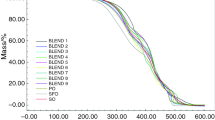Abstract
Effect of (−)-epigallocatechin gallate (EGCG) and (−)-epicatechin (EC) at different concentrations (100–300 ppm) on frying stability of soybean oil blended with tea seed oil was studied. Thermal stability of the blended oil increased with the addition of EGCG and EC, especially with increasing concentrations. Frying induced degradation of tocopherols and phenolics of oils, particularly tocopherols. Incorporation of catechin derivatives could retard tocopherol decomposition and formation of polar materials. The highest frying stability was found for the oil added with EC at 300 ppm. When the oil added with EC (300 ppm) was used to prepare fish crackers, lowered lipid oxidation of the resulting crackers than those prepared using the control oil was noted throughout 12 weeks of storage. EC could be effectively used as natural antioxidant in frying oil with carry through effect to enhance oxidation stability of the fried foods during a storage.


Similar content being viewed by others
References
Aewsiri T, Benjakul S, Visessanguan W, Eun JB, Wierenga W, Gruppen H. Antioxidative activity and emulsifying properties of cuttlefish skin gelatin modified by oxidized phenolic compounds. Food Chem. 117: 60–68 (2009)
Aladedunye FA, Przybylski R. Degradation and nutritional quality changes of oil during frying. J. Am. Oil Chem. Soc. 86: 149–156 (2009)
Ananinsih VK, Sharma A, Zhou WB. Green tea catechins during food processing and storage: A review on stability and detection. Food Res. Intl. 50: 469–479 (2013)
Andrikopoulos NK, Boskou G, Dedoussis GVZ, Chiou A, Tzamtzis VA, Papathanasiou A. Quality assessment of frying oils and fats from 63 restaurants in Athens, Greece. Food Serv. Technol. 3: 49–59 (2003)
AOAC. Official Methods of Analysis of AOAC Intl. Method 982.27. Association of Official Analytical Chemists, Gaithersburg, MD, USA (2002)
AOCS.Official Methods and Recommended Practices of the AOCS. Method Cd 18–90. American Oil Chemists’ Society, Champaign, IL, USA (1994)
AOCS.Official Methods and Recommended Practices of the AOCS. Method Cd 1–25, Ca 5a–40, Cd 8–53. Champaign, IL, USA (1997)
Braicu C, Ladomery MR, Chedea VS, Irimie A, Berindan-Neagoe I. The relationship between the structure and biological actions of green tea catechins. Food Chem. 141: 3282–3289 (2013)
Chen ZY, Chan PT. Antioxidative activity of green tea catechins in canola oil. Chem. Physics Lipids 82: 163–172 (1996)
Chen ZY, Chan PT, Ho KY, Fung KP, Wang J. Antioxidative activity of natural flavonoids is governed by number and location of their aromatic hydroxyl groups. Chem. Physics Lipids 79: 157–163 (1996)
Chirinos R, Pedreschi R, Cedano I, Campos D. Antioxidants from Mashua (Tropaeolum tubersum) control lipid oxidation in Sacha Ichu (Plukenetia volubilis L.) oil and raw ground pork meat. J. Food Process Preserv. 39: 2612–2619 (2015)
Chowdhury K, Banu LA, Khan S, Latif A. Studies on the fatty acid composition of edible oil. Bangladesh J. Sci. Ind. Res. 42: 311–316 (2007)
De Abreu DAP, Losada PP, Maroto J, Cruz JM. Evaluation of the effectiveness of a new active packaging film containing natural antioxidants (from barley husks) that retard lipid damage in frozen Atlantic salmon (Salmo salar L.). Food Res. Intl. 43: 1277–1282 (2010)
Fan FY, Shi M, Nie Y, Zhao Y, Ye JH, Liang YR. Differential behaviors of tea catechins under thermal processing: Formation of non-enzymatic oligomers. Food Chem. 196: 347–354 (2016)
Farag RS, Mahmoud EA, Basuny AM. Use crude olive leaf juice as a natural antioxidant for the stability of sunflower oil during heating. Intl. J. Food Sci. Technol. 42: 107–115 (2007)
Fazel M, Sahari MA, Barzegar M. Determination of main tea seed oil antioxidants and their effects on common Kilka oil. Intl. Food Res. J. 15: 209–217 (2008)
Gliszczyńska-Świgło A, Sikorska E. Simple reversed-phase liquid chromatography method for determination of tocopherols in edible plant oils. J. Chromatogr. A 1048: 195–198 (2004)
Hou Z, Sang S, You H, Lee MJ, Hong J, Chin KV, et al. Mechanism of action of (−)-epigallocatechin-3-gallate: Auto-oxidation-dependent inactivation of epidermal growth factor receptor and direct effect on growth inhibition in human esophageal cancer KYSE 150 cells. Cancer Res. 65: 8049–8056 (2005)
Iqbal S, Bhanger MI. Stabilization of sunflower oil by garlic extract during accelerated storage. Food Chem.100: 246–254 (2007)
Marmesat S, Morales A, Velasco J, Dobarganes MC. Influence of fatty acid composition on chemical changes in blends of sunflower oils during thermal oxidation and frying. Food Chem.135: 2333–2339 (2012)
Matthäus B. Utilization of high-oleic rapeseed oil for deep-fat frying of French fries compared to other commonly used edible oils. Eur. J. Lipid Sci. Technol. 108: 200–211 (2006)
Messina V, Biolatto A, Descalzo A, Sancho A, Baby R, Walsöe de Reca N. Effect of pan-frying in extra-virgin olive oil on odour profile, volatile compounds and vitamins. Intl. J. Food Sci. Technol. 44: 552–559 (2009)
Ramírez R and Cava R. Volatile profiles of dry-cured meat products from three different Iberian × Duroc genotypes. J. Agric. Food Chem. 55: 1923–1931 (2007)
Sanibal EAA, Mancini-Filho J. Frying oil and fat quality measured by chemical, physical, and test kit analyses. J. Am. Oil Chem. Soc. 81: 847–852 (2004)
Seppanen CM, Csallany AS. Formation of 4-hydroxynonenal, a toxic aldehyde, in soybean oil at frying temperature. J. Am. Oil Chem. Soc. 79: 1033–1038 (2002)
Sharma A, Zhou W. A stability of green tea catechins during the biscuit making process. Food Chem. 126: 568–573 (2011)
Srivastava Y, Semwell AD. A study on monitoring of frying performance and oxidative stability of virgin coconut oil (VCO) during continuous/prolonged deep fat frying process using chemical and FTIR spectroscopy. J. Food Sci. Technol. 52: 984–991 (2015)
Taghvaei M, Jafari SM. Application and stability of natural antioxidants in edible oils in order to substitute synthetic additives. J. Food Sci. Technol. 52: 1272–1282 (2015)
Tompkins C, Perkins EG. The evaluation of frying oils with the p-anisidine value. J. Am. Oil Chem. Soc. 76: 945–947 (1999)
Wang R and Zhou W. Stability of tea catechins in the breadmaking process. J. Agric. Food Chem. 52: 8224–8229 (2004)
Warner K, Glynn M. Effect of fatty acid composition of oils on flavor and stability of fried foods. J. Am. Oil Chem. Soc. 74: 347–356 (1997)
Warner K, Gupta M. Potato chip quality and frying oil stability of high oleic acid soybean oil. J. Food Sci. 70: 395–400 (2005)
Zhang X, Wu Z, Weng P, Yang Y. Analysis of tea catechins in vegetable oils by high–performance liquid chromatography combined with liquid–liquid extraction. Intl. J. Food Sci. Technol. 50: 885–891 (2015)
Acknowledgements
The research was conducted by the supported grants from The Thailand Research Fund (Contract No. MRG5980106).
Author information
Authors and Affiliations
Corresponding author
Ethics declarations
The authors declare no conflict of interest.
Rights and permissions
About this article
Cite this article
Prabsangob, N., Benjakul, S. Effect of tea catechin derivatives on stability of soybean oil/tea seed oil blend and oxidative stability of fried fish crackers during storage. Food Sci Biotechnol 28, 679–689 (2019). https://doi.org/10.1007/s10068-018-0515-x
Received:
Revised:
Accepted:
Published:
Issue Date:
DOI: https://doi.org/10.1007/s10068-018-0515-x




